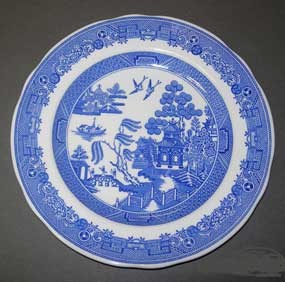

BLUE WILLOW TRANSFERWARE The Blue Willow pattern was introduced in England by the Spode factory in the late 1790s. During the 18th century Europe was fascinated by all things Chinese and especially their beautifully hand-painted china with scenes of Chinese landscapes. The Blue Willow pattern is not an exact copy of a Chinese pattern but rather based on several traditional Chinese designs. The plates produced by Spode and later factories were transferware. The design was etched onto a copper plate and then printed onto a thin piece of paper. That paper was applied to the plate and then fired. Thus the design was "transferred" rather than hand-painted, making the plates much easier to produce and more affordable. Blue Willow became a popular pattern not only in England, but across the ocean in the United States. Beautifully decorated Blue Willow plates, cups, saucers, and serving pieces were carefully packed up and transported by American families moving west. As early as 1820 the wives of some of the officers at Fort Smith were permitted to join their husbands. Their presence and the items they brought with them had a civilizing influence on the fort. Other patterns similar to Blue Willow were also favored by Americans. Blue and white were the most popular colors for dishes in the 19th century and this is reflected in the fragments found at Fort Smith. The Blue Willow pattern tells the legend of two ill-fated Chinese lovers. The story has several variations, but its basic premise remains the same. A beautiful young girl from a prominent family falls in love with her father's clerk. They are prevented from marrying and so decide to elope. Her father pursues them and in some versions of the story they are killed by fire and in other versions, they commit suicide. All stories end with the two lovers being transformed into love birds, united forever. The Blue Willow pattern has changed some over time but the basic elements are the temple or palace, a footbridge with three people, a boat with another figure, a willow tree, and of course the two birds. Apple trees, flowers, and a garden fence appear quite often. How many traditional elements of the Willow pattern can you see on these fragments found at Fort Smith? Look at the reproduction plate to see where these elements are featured. Click here to see a larger image of the reproduction plate. (It will open in a new window.) To view the plate next to the fragments, click here. (Image will open in a new window.) Click here to return to Artifacts of the Park.
|
Last updated: April 10, 2015
